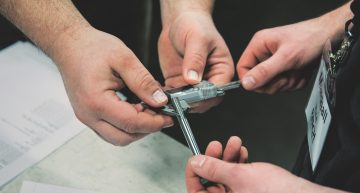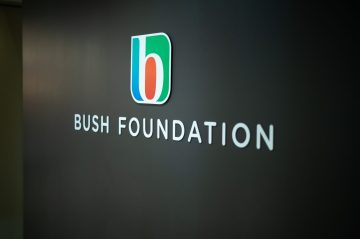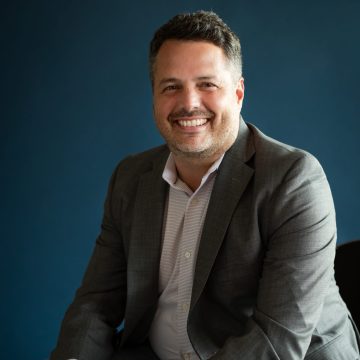Story
Manufacturers & Public Schools: A Winning Combination

Across the state, companies are struggling to fill jobs, especially skilled positions. At the same time, public schools are challenged to connect students to the real world. To bridge this gap, manufacturers and public schools in Winona, Minnesota, have teamed up to rethink how classrooms prepare students for life after graduation.
The quiet murmur building in Winona, Minnesota, over the past few years had grown into a roar. Manufacturers in town all shared a common challenge: They couldn’t find enough skilled workers. The shortage was nearing a crisis.
For more than two years, Peerless Industrial Group couldn’t fill a maintenance electrician position. At one point, Benchmark Electronics counted more than 100 job openings in its facility. Day after day, frustration boiled over.
“We constantly had an ad in the paper for tool and die makers,” says Tom Wynn, the former president and CEO at Peerless. “If our companies can’t find skilled workers, they have to go somewhere else. None of us want to do that. We’re proud we have so much manufacturing in our town. We want to keep it that way.”
Winona was experiencing a symptom of a larger, pervasive issue. According to the Minnesota Chamber of Commerce, the number of businesses across the state that struggled to find employees more than tripled between 2009 and 2017 — rising from 21 percent to 71 percent.
Simultaneously, Winona-area schools were facing challenges of their own. Not all students were succeeding in high school. In fact, the spring 2017 graduation rate for the Winona School District, 83.1 percent, barely outpaces the statewide level of 82.2 percent. And those who do make it to graduation don’t always possess the skills needed to gain employment.
Faced with these growing concerns, the chamber set out to find new ways to prepare high school students for future employment, and connect Minnesota companies with those who might join their ranks in the future.
Creating REACH
With a $300,000 grant from the Bush Foundation, the chamber piloted a new Business Education Networks initiative in Winona. Through it, local employers teamed up with the Winona Area Chamber of Commerce to prepare students for career opportunities in the community. In 2017, the initiative started a unique program, REACH, in partnership with area schools and manufacturers to invest in the next generation. The idea was simple: Make education relevant to students’ career interests by bringing companies into the curriculum.
“We want the emerging workforce to have a clearer pathway to careers that match their interests, passion and skills,” says Della Schmidt, the president of the Winona Area Chamber of Commerce. “We need to make sure the educational system is aligning with where the jobs are going to be. It’s important for the business community to lead the conversation because we are the ultimate employer.”
A Shared Solution
Landing a job wasn’t easy. Seventeen-year-old Devon Moss didn’t even know how to fill out an application. He asked his dad for help with the first one, but didn’t feel confident finishing one on his own until he sat down in Rhonda Aspenson’s workplace skills class, part of the REACH program, at the start of the school year in September 2017.
For 90 minutes a day, Aspenson practiced skills with REACH students that would improve their chances of finding and keeping a job. Moss learned how to write a resume, network and talk to prospective employers. That’s when he realized a mistake he was making in applications. He was so used to using slang and abbreviations in text messages to friends, that he started using the same shorthand in emails to potential managers.
“It didn’t work out so well. I learned that quick,” says Moss, who stopped writing “lol” in job-seeking emails when he was joking or thought something was funny.
With Aspenson’s guidance, the high school junior began dressing more professionally for his first job at Arby’s, and even gained the brass to apply for a more competitive position at one of the manufacturing companies in town, Fastenal, the largest fastener distributor in the country. He hopes REACH will springboard him to his next career move, too: first college, and then a job as a 3D or graphic designer.
We’ve been using outdated educational models where the students are all treated the same,” says Schmidt, who leads the REACH initiative at the chamber. But with REACH, she continues, “We have the opportunity to change lives for the better and to give these students a hope and vision for their future.”
Students like Moss are benefitting from REACH’s individualized approach, a marked alternative to the one-size-fits-all approach to education. “We’ve been using outdated educational models where the students are all treated the same,” says Schmidt, who leads the REACH initiative at the chamber. But with REACH, she continues, “We have the opportunity to change lives for the better and to give these students a hope and vision for their future.”
The two-year program for juniors and seniors lets them earn up to 19 college credits for high school classes, get off campus to tour local businesses and apply for paid internships at Winona manufacturers their senior year. Most of all, it encourages students to start thinking earlier about what comes after graduation.
At the beginning of the 2017-18 school year, REACH launched with a cohort of 30 students. In its first run, the program targeted a group of juniors who, for one reason or another, planned to stay in the Winona area after graduation but were undecided about whether or not to pursue advanced education. Many of these teenagers were falling through the cracks at school. They weren’t interested in coursework, missed classes too often or faced financial challenges at home. To be selected for REACH, each student had to write an application that demonstrated a renewed desire to succeed.
“If we can impact and inspire this group of students, then just imagine what we could do as we expand in the future,” says Schmidt, who will open up the program to 90 high school students starting in the 2018-19 school year, and broaden REACH’s employer portfolio to include a health and human services career pathway.
Today’s manufacturing jobs aren’t often what people expect. Employees need critical thinking, design chops and computer-programming skills.
Throughout the school year, the 30 teenagers in the program learned how to read blueprints, use computer-aided design or drafting software to render new products, and operate CNC machines, a device that controls machine shop tools through computer programming. Aside from technical know-how, students picked up on soft skills, too — such as work ethic, communication and teamwork — that employers say job candidates and recent hires often lack.
“If you have people coming in without those skills or expectations, you have a worker who just isn’t ready to be a part of a business environment,” says Corey Hancock of Benchmark Electronics, one of Winona’s largest manufacturing companies. “When you’re running a manufacturing operation, you’re relying on everyone being on time for their role. When someone doesn’t show up unexpectedly, there’s a lot of disruption.”
When students visited Benchmark in November 2017, they got a taste of what it means to work in manufacturing by testing simple circuits, matching blueprints to incoming materials and watching how R&D engineers use 3D printers to develop products. Today’s manufacturing jobs aren’t often what people expect. Employees need critical thinking, design chops and computer-programming skills in order to create medical devices for companies like Medtronic, or build some of the world’s fastest supercomputers like Benchmark does. For Hancock, it’s important to get students through the door so they can see those opportunities for themselves.
“You can drive past a company like Benchmark every day, but never understand what they do and know if it’s something you’d be interested in,” he says.
“They have a reason to be in school,” says Principal Mark Anderson. “Kids who haven’t talked to people in the past are looking them in the eyes, starting conversations and shaking hands. It’s not something they did before.”
Employers & Educators Unite
Just three months into REACH, Winona Senior High School teachers started seeing a change in their students. Kids who used to sit alone or struggled to start conversations with adults started coming out of their shells. GPAs went up, while unexcused absences and tardies went down.
“They have a reason to be in school,” says Principal Mark Anderson. “Kids who haven’t talked to people in the past are looking them in the eyes, starting conversations and shaking hands. It’s not something they did before.”
Now those habits are common practice when students attend industry luncheons or tour local companies like Fastenal. For Anderson, REACH is an opportunity for juniors and seniors to test-drive career options before they commit to an expensive college or get locked into a job.
“Our kids have always told us they want out of the building. That’s not a bad thing,” he says. “What they’re telling us is, ‘Let us go figure out who we need to be after high school.’”
REACH breaks ground by putting employers at the heart of those conversations. For the first time, businesses have a direct line of communication to students through the schools. They can share the types of jobs that are available in Winona, and what skills students will need to get hired. That’s invaluable information for teenagers and teachers alike.
“The vast majority of our educators haven’t spent time working in the private sector, yet it’s their job to educate these teenagers to enter that community,” says Schmidt. “We have a big disconnect between the classroom, which is producing our future workers, and the business community where they’ll eventually work.”
Inside information from business leaders gives teachers like Aspenson the confidence to adapt their curriculum to fit the current employment landscape, and the credibility to promise students the skills they’re learning will make them marketable in the future.
However, bringing two vastly different industries together required the right pacing. “If I put 10 business people in the room with 10 teachers, they would not have been as effective in their communication,” says Schmidt, who initially separated employers and educators into two groups. The REACH Advisory Council, made up of business leaders, outlined the initial plan for the program. When it came time to decide how that vision would fit within the school system, Schmidt turned to a group of educators, counselors and school leaders to workshop the idea. “We were able to share ideas, needs and desired outcomes without getting stuck in the weeds or in what makes us different,” she says. To ensure educators and employers always had a voice at one another’s meetings, Schmidt and Anderson participated in both groups.
The two teams came together for a joint brainstorming session as REACH students prepared to head out into the community on immersion experiences — hands-on tours at local manufacturers that let students learn about jobs firsthand. At the meeting, host companies told teachers about the work they do and what they hoped to show students when they visited. Teachers gave feedback on what would be appropriate for 16- and 17-year-old students to see, as well as how the immersion experiences could play off their classroom curriculum.
“They tell us what they need, and we tell them what we need,” says Schmidt, who is excited to see where the next five years take her soon-to-be high school graduates. “We work together to create great future employees.”
Continue reading
-

News
Opportunity to work with us
As part of our office move later this year, we are exploring possibilities for the build out of the ground floor of the building. We are in the early stages of this and considering different types of operating models and potential partnerships.
-

Staff note
Coordinating the work of our contact hub
We aim to be radically open in all that we do, and that includes being more accessible to more people and sharing what we learn along the way.
-

Staff note
Making every dollar work through impact investing
We have benefitted from the experience of other funders as we developed our impact investing approach. Now we are paying it forward and sharing what we have done and what we have learned.